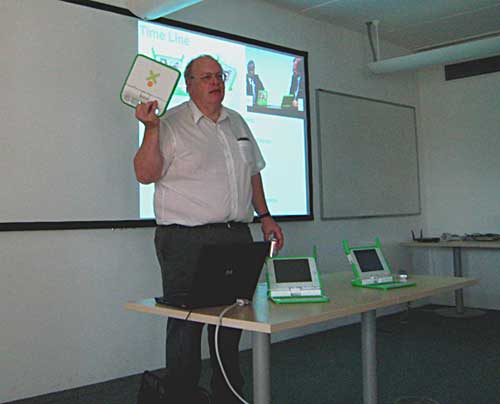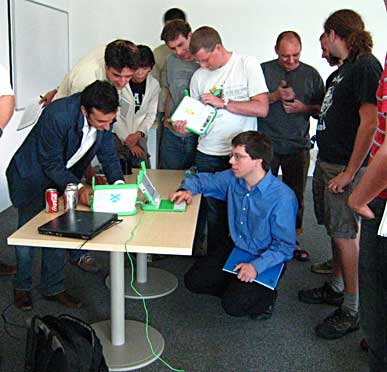
Jim Gettys, VP of Software for the One Laptop Per Child project was in Cambridge today and gave an impromptu seminar at the Computer Lab. It was a fascinating insight into the amount of hard work and ingenuity that has gone into the design of this elegant little gizmo:

Jim had three of the laptops in his bag and left them out for us to examine.
I took notes as he talked and may blog a full account later. But, looking back, the headlines are:
Wireless networking is central to the project, and it does mesh networking in a really neat way. My Airport card picked up the mesh immediately, and it was interesting to see the neat way the OLPC interface represents other wireless nets. They’ve done a lot of hard thinking about power consumption and have come up with some very neat tricks for paring down consumption. The CPU is off much of the time, for example. The display (a custom-built 7.5″ 200 dpi TFT ultra-low power consumption screen) is readable in bright sunlight. Jim had a nice slide of the laptop alongside a traditional HP laptop in blazing sunshine. Guess which screen is an unreadable black? The laptop has a built-in camera — rather like the iSight built in to Intel Macs. Kids love this, apparently. There are plans to sell OEM versions of the laptop in developed countries — but for considerably more than $100. Conventional file systems are pretty baffling to a young kid who doesn’t know how to read yet. So the OLPC has, as its central idea, the concept of a time-ordered journal. (This also helps with decisions about what to throw away: you’re less tempted to keep old stuff). The OLPC Chat protocol is “loosely based” on Jabber. Open source software is a key and integral part of the project. Making the machines look very much like a kids’ toy is part of the anti-theft strategy. (Any adult with one who isn’t a teacher will be suspect.) Also it helps that it doesn’t run Windows (makes it less desirable to thieves). The project is running into ‘political’ difficulties in certain targeted countries. These difficulties are partly caused by certain Western companies — but, interestingly, not Microsoft. Now I wonder which large chip manufacturer might be involved?
After Jim had finished, he was mobbed by a few people. The students went straight for the laptops, though!

All in all, it was a terrific event. Thanks to Jon Crowcroft for organising it.
Postscript: The “bunny ears” on the laptop are in fact WiFi antennae!

